Top five presentations from the Quirk's Event – Dallas
Editor’s Note: This is an edited version of an article that originally appeared under the title “Five Presentations You Didn’t Want to Miss” on LinkedIn.
Quirk’s never disappoints! Dallas isn’t as big of a conference as New York, which gave us a bit of extra time to talk to presenters.
If you haven’t been to any conferences in the last year, there was plenty of stuff on AI and qual analysis (i.e. using ChatGPT or similar tools to analyze interviews). I’m going to pass on this stuff just because we’ve seen it before.
I can’t call this the top five because I couldn’t see everything, but here are some of the most interesting presentations you may have missed!
Awakening a sleepy category: Leveraging emerging signals and need states to inspire consumers to engage with a burden category
Suann Griffin from Serta Simmons, Betsy Pendergast from Ebco
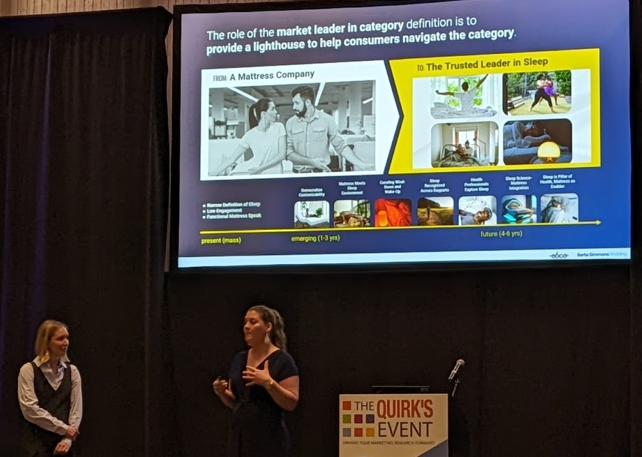 So, you thought mattresses were boring and low tech? The sleep category is anything but drowsy these days. (Did you really think you could avoid the dad jokes?)
So, you thought mattresses were boring and low tech? The sleep category is anything but drowsy these days. (Did you really think you could avoid the dad jokes?)
I found this presentation inspiring because it highlighted the dramatic impact that insights people can have on a multi-billion-dollar company. Five years ago, Serta found itself with a thin innovation pipeline in an increasingly competitive industry. Today, Serta proudly boasts a strongly differentiated product lineup that’s clearly articulated to consumers, with more to come!
The story of how they navigated that journey is impressive! It culminated in their emergence from Chapter 11 Bankruptcy, with the financial press giving credit for their strength to their innovative product portfolio. To build that portfolio, they and their partners leveraged every tool in the kit (even while they were going through financial challenges), including interviewing sleep science experts and consumers to rebuild their understanding of value and benefits from the ground up.
For anyone that says insights can’t change a company, don’t believe them!
Generative AI: Expectations vs. reality
Lynn Slawsky from Rotary, Lloyd Yoo from Stravito
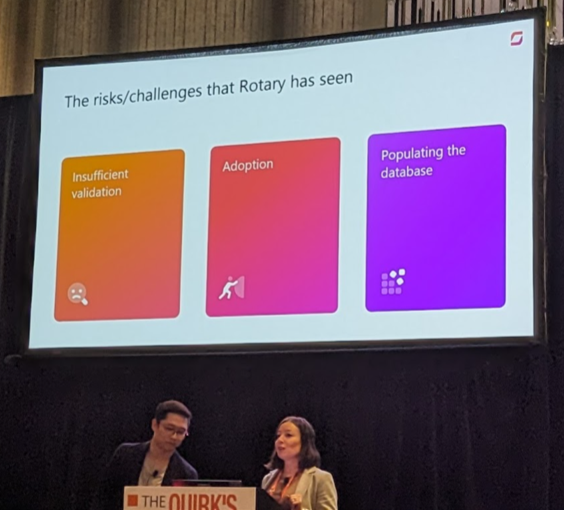 I give this presentation an A-plus for honesty and value. Most of the AI talks we hear are all about the hype and cool factor (and it IS cool), but Slawsky and Yoo gave an honest appraisal of the benefits and challenges of incorporating AI into a company’s knowledge infrastructure. Even before ChatGPT, Stravito was indexing and organizing company knowledge bases, and LLMs just accelerated that.
I give this presentation an A-plus for honesty and value. Most of the AI talks we hear are all about the hype and cool factor (and it IS cool), but Slawsky and Yoo gave an honest appraisal of the benefits and challenges of incorporating AI into a company’s knowledge infrastructure. Even before ChatGPT, Stravito was indexing and organizing company knowledge bases, and LLMs just accelerated that.
One promise of LLMs is that they can just read all your company’s data and insights and tell you what you need to know – even build reports for you. When Rotary launched, their stakeholders were over-the-top excited to try it out. Within months, however, project participation and perceived value dropped. Users found all the standard challenges – especially with getting exactly the data and formatted output they wanted.
Was the initiative worthwhile? Yes, but both presenters emphasized how critical it is to set expectations (and maybe stage delivery) to avoid creating a “trough of disillusionment” after the initial peak of inflated expectations.
Evaluating the performance and future of emotion AI
Aaron Reid from Sentient Decision Sciences
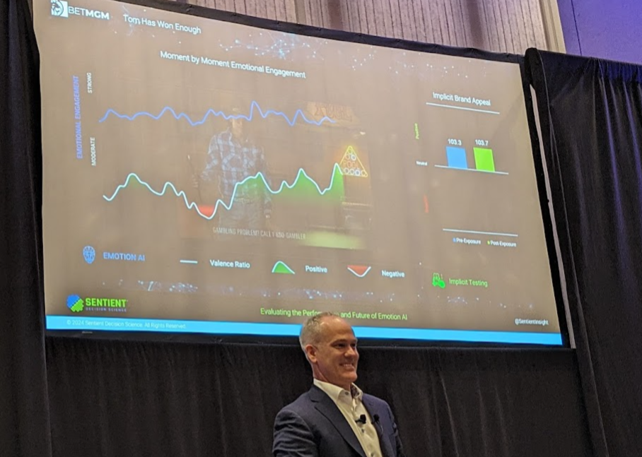 Aaron founded his company 17 years ago! Since then, they’ve moved beyond implicit association testing (good, but very expensive and limited) to emotion detection. Technology has come a long way. We no longer have to bring a small handful of people into a laboratory and hook them up to galvanic skin sensors. Facial expression detection can now measure discrete emotions (joy, sadness, etc.) with reasonable accuracy.
Aaron founded his company 17 years ago! Since then, they’ve moved beyond implicit association testing (good, but very expensive and limited) to emotion detection. Technology has come a long way. We no longer have to bring a small handful of people into a laboratory and hook them up to galvanic skin sensors. Facial expression detection can now measure discrete emotions (joy, sadness, etc.) with reasonable accuracy.
I am a bit skeptical about the reported data – the accuracy rates of 90% to 97% sound a bit high. The best I see in academic literature is 75% to 80% (with human accuracy at about 90%). Nonetheless, it’s still pretty good for measuring emotional response to people watching a 30 second ad on a mobile phone.
The specific uses cases we saw were convincing – though they were kind of easy. One was a cringe-worthy ad with people eating light bulbs, and others were well-vetted Superbowl ads. I’d like to see how emotion AI works on regular ads and how it compares to other methods, but I do think the technology is worth a trial if you do a lot of ad measurement.
Navigating the Great Respondent Revolt/Seven major problems in insights today/A new era: How John Deere is harvesting deeper insights with conversational, mobile-first communities
Jason Jacobson from Sekisui, Jonathan Dore from Reach3 Insights, Bryan Dorsey from John Deere
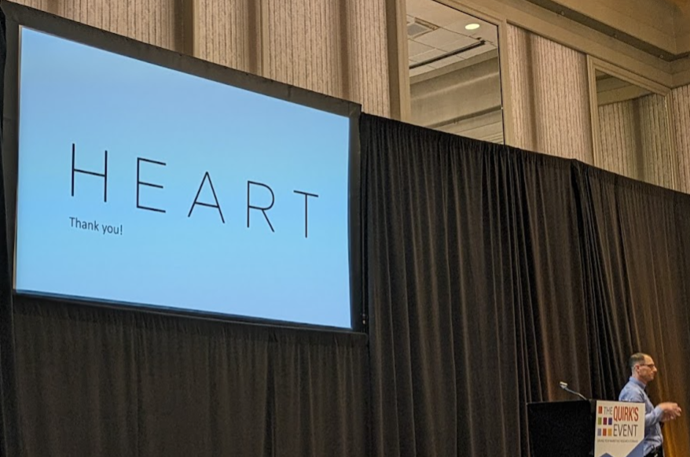 Jacobson didn’t give a self–promotional sales pitch – he highlighted issues our industry needs to work on. One of these is treating our respondents with respect. (Karine Pepin here’s your cue!) The massive industry issues with respondent fraud and low-quality responses are not even a dirty little secret anymore – it’s a giant elephant in the room. The conventional approach is to just remove more respondents. Quality enforcement is critical, but it’s also like saying “beatings will continue until morale improves.” Jacobson covered several ways you can make your research more respondent friendly, including using new technologies.
Jacobson didn’t give a self–promotional sales pitch – he highlighted issues our industry needs to work on. One of these is treating our respondents with respect. (Karine Pepin here’s your cue!) The massive industry issues with respondent fraud and low-quality responses are not even a dirty little secret anymore – it’s a giant elephant in the room. The conventional approach is to just remove more respondents. Quality enforcement is critical, but it’s also like saying “beatings will continue until morale improves.” Jacobson covered several ways you can make your research more respondent friendly, including using new technologies.
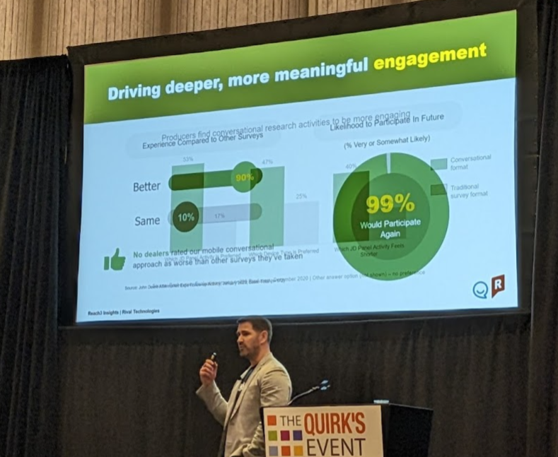 Dorsey went a step further, since most of his respondents were farmers who took nearly all their surveys on phones while operating tractors. He talked about different strategies to recruit them, but also to keep them engaged with conversational and mobile first surveys. Their partner was Reach3 Insights.
Dorsey went a step further, since most of his respondents were farmers who took nearly all their surveys on phones while operating tractors. He talked about different strategies to recruit them, but also to keep them engaged with conversational and mobile first surveys. Their partner was Reach3 Insights.
Creating a better B2B survey: Business professionals speak out
Greg Matheson and Scott Worthge, Quest Mindshare
 It’s rare that someone spends thousands of dollars to do research-on-research to share with everyone. B2B survey takers are expensive, tough to find and easily annoyed. Worthge dove into specific areas that B2B survey takers hate and explained how to keep them in your surveys – with a few surprises!
It’s rare that someone spends thousands of dollars to do research-on-research to share with everyone. B2B survey takers are expensive, tough to find and easily annoyed. Worthge dove into specific areas that B2B survey takers hate and explained how to keep them in your surveys – with a few surprises!
You might think LOI over 15 minutes is bad, and it is, but it’s not the worst thing. B2B survey takers hate grid questions, and they hate surveys that don’t make sense for them and their industry. They hate giving you personal data (like their gender) which doesn’t seem relevant, and they really hate long screeners that force them to complete the whole thing before they find out they’re disqualified.
Great, practical advice for clients and suppliers doing B2B research.
That's not all...
So that’s five (really six) great presentations. There were several other awesome presentations that I hope to cover in some follow-ups.
Michael Nevski from Visa did a great presentation on the importance of brand trust (especially given global events). Natalie Armstrong from Mary Kay had an amazingly interesting presentation on brand mapping with sensory data. Genevieve Gonzalez-Turner from The Wonderful Company, talked about improving brand trackers using situational questions to measure mental availability. And I loved the presentation from Deborah Walker and Natalie Kakovitch from Michaels Store Inc. on using customer insights to build a new online marketplace.
For anyone I missed at the Quirk’s Event – Dallas, I hope to catch you at the Insights Association Annual Conference in April or another conference!
